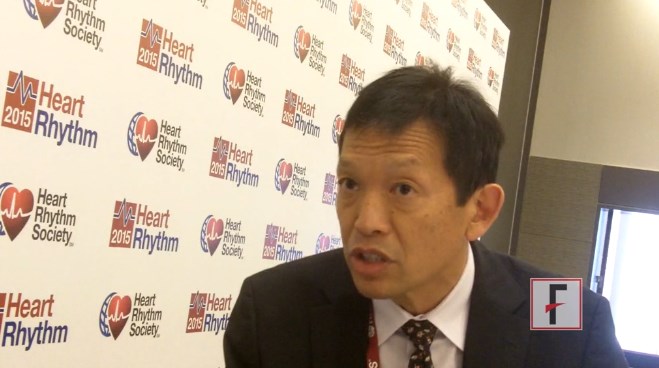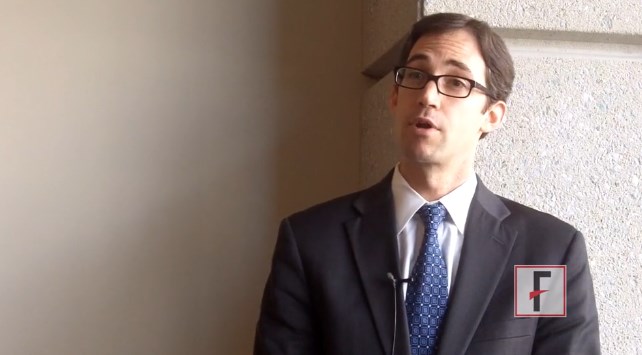User login
Heart Rhythm Society (HRS): Heart Rhythm 2015
VIDEO: MRI-compatible ICDs represent important advance
BOSTON – The prospect of soon having two new, different options for placing implantable cardioverter defibrillators (ICDs) that can safely undergo MRI exposure is “really important,” Dr. Fred M. Kusumoto said in an interview at the annual scientific sessions of the Heart Rhythm Society.
Researchers presented results from two independent, pivotal trials that showed the safety and efficacy of one of the new devices in patients who underwent MRI with 1.5 Tesla imagers.
Once the devices come onto the U.S. market they will likely be placed first in younger patients as well as older patients who seem likely to need MRI in the foreseeable future. As electrophysiologists grow more comfortable with the MRI-compatible ICDs, their use will gradually become more commonplace, Dr. Kusumoto predicted. That’s what happened when MRI-compatible pacemakers first became available, noted Dr. Kusumoto, professor of medicine and an electrophysiologist at the Mayo Clinic in Jacksonvile, Fla.
The next frontier for MRI-compatible implanted cardiac devices will be cardiac resynchronization therapy units, but with their more complicated design and lead placement that step will pose additional design and engineering challenges, he said.
Dr. Kusumoto had no relevant disclosures.
The video associated with this article is no longer available on this site. Please view all of our videos on the MDedge YouTube channel
On Twitter @mitchelzoler
This article was updated 5/18/2015.
BOSTON – The prospect of soon having two new, different options for placing implantable cardioverter defibrillators (ICDs) that can safely undergo MRI exposure is “really important,” Dr. Fred M. Kusumoto said in an interview at the annual scientific sessions of the Heart Rhythm Society.
Researchers presented results from two independent, pivotal trials that showed the safety and efficacy of one of the new devices in patients who underwent MRI with 1.5 Tesla imagers.
Once the devices come onto the U.S. market they will likely be placed first in younger patients as well as older patients who seem likely to need MRI in the foreseeable future. As electrophysiologists grow more comfortable with the MRI-compatible ICDs, their use will gradually become more commonplace, Dr. Kusumoto predicted. That’s what happened when MRI-compatible pacemakers first became available, noted Dr. Kusumoto, professor of medicine and an electrophysiologist at the Mayo Clinic in Jacksonvile, Fla.
The next frontier for MRI-compatible implanted cardiac devices will be cardiac resynchronization therapy units, but with their more complicated design and lead placement that step will pose additional design and engineering challenges, he said.
Dr. Kusumoto had no relevant disclosures.
The video associated with this article is no longer available on this site. Please view all of our videos on the MDedge YouTube channel
On Twitter @mitchelzoler
This article was updated 5/18/2015.
BOSTON – The prospect of soon having two new, different options for placing implantable cardioverter defibrillators (ICDs) that can safely undergo MRI exposure is “really important,” Dr. Fred M. Kusumoto said in an interview at the annual scientific sessions of the Heart Rhythm Society.
Researchers presented results from two independent, pivotal trials that showed the safety and efficacy of one of the new devices in patients who underwent MRI with 1.5 Tesla imagers.
Once the devices come onto the U.S. market they will likely be placed first in younger patients as well as older patients who seem likely to need MRI in the foreseeable future. As electrophysiologists grow more comfortable with the MRI-compatible ICDs, their use will gradually become more commonplace, Dr. Kusumoto predicted. That’s what happened when MRI-compatible pacemakers first became available, noted Dr. Kusumoto, professor of medicine and an electrophysiologist at the Mayo Clinic in Jacksonvile, Fla.
The next frontier for MRI-compatible implanted cardiac devices will be cardiac resynchronization therapy units, but with their more complicated design and lead placement that step will pose additional design and engineering challenges, he said.
Dr. Kusumoto had no relevant disclosures.
The video associated with this article is no longer available on this site. Please view all of our videos on the MDedge YouTube channel
On Twitter @mitchelzoler
This article was updated 5/18/2015.
AT HEART RHYTHM 2015
VIDEO: Remote monitoring of cardiac devices cuts hospitalizations
BOSTON – Remote monitoring of cardiovascular implantable electronic devices dramatically improved patient outcomes and cut health care costs by keeping patients out of the hospital and reducing lengths of stays when hospitalization was needed, a retrospective analysis showed.
Remote monitoring “led to improved outcomes, more convenience for patients, and saved money, truly a win-win-win,” in the study of real-world data collected on more than 92,000 U.S. patients during 2008-2013, said Dr. Jonathan P. Piccini Sr. in an interview at the annual scientific sessions of the Heart Rhythm Society.
Using the MarketScan database of U.S. patients covered by commercial insurance or Medicare, Dr. Piccini and his associates analyzed hospitalization records for 92,566 patients who received an implanted pacemaker, implantable cardioverter defibrillator, or cardiac resynchronization device during the study period. Roughly a third of the patients underwent remote monitoring along with their routine clinic visits while the rest were followed exclusively by clinic visits.
The data showed that remotely monitored patients had a statistically significant 18% lower rate of hospitalizations during follow-up and a 35% cut in their average length of stay when hospitalized. This resulted in a 30% drop in hospitalization costs, compared with costs for similar patients who did not undergo remote monitoring of their implanted devices. The cost savings remote monitoring produced meant that every 100,000 patient-years of remote monitoring saved about $370 million in hospital costs.
Coincident with the meeting, an expert panel of the Heart Rhythm Society released a statement on remote monitoring for cardiovascular implantable electronic devices (CIEDs) (Heart Rhythm 2015 [doi: 10.1016/j.hrthm.2015.05.008]. The statement said that “remote monitoring represents the new standard of care for patients with CIEDs.” But Dr. Piccini’s findings showed that U.S. clinicians vastly underused remote monitoring, with two-thirds of U.S. CIED recipients failing to undergo remote monitoring during 2008-2013. “Increased monitoring is a huge opportunity for health care improvement,” said Dr. Piccini, a cardiologist and an electrophysiologist at Duke University in Durham, N.C.
Dr. Piccini has been a consultant to Medtronic and has received research grants from Boston Scientific.
The video associated with this article is no longer available on this site. Please view all of our videos on the MDedge YouTube channel
Twitter @mitchelzoler
BOSTON – Remote monitoring of cardiovascular implantable electronic devices dramatically improved patient outcomes and cut health care costs by keeping patients out of the hospital and reducing lengths of stays when hospitalization was needed, a retrospective analysis showed.
Remote monitoring “led to improved outcomes, more convenience for patients, and saved money, truly a win-win-win,” in the study of real-world data collected on more than 92,000 U.S. patients during 2008-2013, said Dr. Jonathan P. Piccini Sr. in an interview at the annual scientific sessions of the Heart Rhythm Society.
Using the MarketScan database of U.S. patients covered by commercial insurance or Medicare, Dr. Piccini and his associates analyzed hospitalization records for 92,566 patients who received an implanted pacemaker, implantable cardioverter defibrillator, or cardiac resynchronization device during the study period. Roughly a third of the patients underwent remote monitoring along with their routine clinic visits while the rest were followed exclusively by clinic visits.
The data showed that remotely monitored patients had a statistically significant 18% lower rate of hospitalizations during follow-up and a 35% cut in their average length of stay when hospitalized. This resulted in a 30% drop in hospitalization costs, compared with costs for similar patients who did not undergo remote monitoring of their implanted devices. The cost savings remote monitoring produced meant that every 100,000 patient-years of remote monitoring saved about $370 million in hospital costs.
Coincident with the meeting, an expert panel of the Heart Rhythm Society released a statement on remote monitoring for cardiovascular implantable electronic devices (CIEDs) (Heart Rhythm 2015 [doi: 10.1016/j.hrthm.2015.05.008]. The statement said that “remote monitoring represents the new standard of care for patients with CIEDs.” But Dr. Piccini’s findings showed that U.S. clinicians vastly underused remote monitoring, with two-thirds of U.S. CIED recipients failing to undergo remote monitoring during 2008-2013. “Increased monitoring is a huge opportunity for health care improvement,” said Dr. Piccini, a cardiologist and an electrophysiologist at Duke University in Durham, N.C.
Dr. Piccini has been a consultant to Medtronic and has received research grants from Boston Scientific.
The video associated with this article is no longer available on this site. Please view all of our videos on the MDedge YouTube channel
Twitter @mitchelzoler
BOSTON – Remote monitoring of cardiovascular implantable electronic devices dramatically improved patient outcomes and cut health care costs by keeping patients out of the hospital and reducing lengths of stays when hospitalization was needed, a retrospective analysis showed.
Remote monitoring “led to improved outcomes, more convenience for patients, and saved money, truly a win-win-win,” in the study of real-world data collected on more than 92,000 U.S. patients during 2008-2013, said Dr. Jonathan P. Piccini Sr. in an interview at the annual scientific sessions of the Heart Rhythm Society.
Using the MarketScan database of U.S. patients covered by commercial insurance or Medicare, Dr. Piccini and his associates analyzed hospitalization records for 92,566 patients who received an implanted pacemaker, implantable cardioverter defibrillator, or cardiac resynchronization device during the study period. Roughly a third of the patients underwent remote monitoring along with their routine clinic visits while the rest were followed exclusively by clinic visits.
The data showed that remotely monitored patients had a statistically significant 18% lower rate of hospitalizations during follow-up and a 35% cut in their average length of stay when hospitalized. This resulted in a 30% drop in hospitalization costs, compared with costs for similar patients who did not undergo remote monitoring of their implanted devices. The cost savings remote monitoring produced meant that every 100,000 patient-years of remote monitoring saved about $370 million in hospital costs.
Coincident with the meeting, an expert panel of the Heart Rhythm Society released a statement on remote monitoring for cardiovascular implantable electronic devices (CIEDs) (Heart Rhythm 2015 [doi: 10.1016/j.hrthm.2015.05.008]. The statement said that “remote monitoring represents the new standard of care for patients with CIEDs.” But Dr. Piccini’s findings showed that U.S. clinicians vastly underused remote monitoring, with two-thirds of U.S. CIED recipients failing to undergo remote monitoring during 2008-2013. “Increased monitoring is a huge opportunity for health care improvement,” said Dr. Piccini, a cardiologist and an electrophysiologist at Duke University in Durham, N.C.
Dr. Piccini has been a consultant to Medtronic and has received research grants from Boston Scientific.
The video associated with this article is no longer available on this site. Please view all of our videos on the MDedge YouTube channel
Twitter @mitchelzoler
AT HEART RHYTHM 2015

